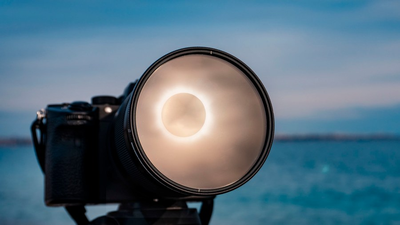
LAS VEGAS (KLAS) — Photographers, both professional and amateur alike, are excited about capturing the moment the solar eclipse becomes a ring of fire, obscuring the sun. But photography experts say just pointing your smartphone camera at the eclipse could cause catastrophic damage if you don't have proper equipment.
"How do I protect my camera sensor being totally destroyed by this thing?" is the No. 1 question Adam Gallardo, manager at B&C Camera in Las Vegas, said photographers are asking him as they visit the store this week.
"Digital cameras, DSLRs, mirrorless cameras, even your phone [...] all have sensors," Gallardo said. "It's really not a good idea to point them directly to the sun, especially during this solar eclipse without the proper equipment."
A solar filter, Gallardo said, is essential to photograph a solar eclipse. Viewing an eclipse through a camera lens, telescope or binoculars without a special filter could cause serious eye damage.
The filter blocks out most of the sunlight. While that may seem counterintuitive when attempting to take photos of the sun, it could be the difference between a permanently damaged sensor and your camera being able to photograph for another day.
"It's really dangerous to look at it directly with your eyes, so it's going to be the same thing for your camera," Gallardo said.
Gallardo had some other tips for eclipse photographers. He recommended using a tripod for stability, especially for those using their zoom features or telephoto lenses. Many photographers, Gallardo said, prefer to use remote and wireless triggers to snap photos of the eclipse, allowing them to stand farther away from their cameras so as not to jostle them while shooting.
NASA photographer Bill Ingalls suggests focusing on the event surrounding the eclipse to take truly memorable shots. "The real pictures are going to be of the people around you pointing, gawking, and watching it," Ingalls said. "Those are going to be some great moments to capture to show the emotion of the whole thing."
Eclipse chasers will have to head to the less-than-150-mile-wide track of annularity illustrated on the map below if they want to see the "ring of fire" on Saturday.
The full annular eclipse will start at 9:13 a.m. local time in Oregon and end in the U.S. at 12:03 p.m. in Texas.
Other tips from NASA experts include photographers being comfortable with their cameras ahead of the big moment and to practice, learning how to manually focus the camera for the sharpest shots possible.